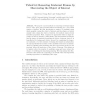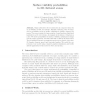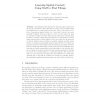ECCV
2008
Springer
16 years 28 days ago
2008
Springer
Sliding window classifiers are among the most successful and widely applied techniques for object localization. However, training is typically done in a way that is not specific to...
ECCV
2008
Springer
16 years 28 days ago
2008
Springer
We present a new Gaussian Process inference algorithm, called Online Sparse Matrix Gaussian Processes (OSMGP), and demonstrate its merits with a few vision applications. The OSMGP ...
ECCV
2008
Springer
16 years 28 days ago
2008
Springer
We propose a novel method for removing irrelevant frames from a video given user-provided frame-level labeling for a very small number of frames. We first hypothesize a number of c...
ECCV
2008
Springer
16 years 28 days ago
2008
Springer
Shape optimization is a problem which arises in numerous computer vision problems such as image segmentation and multiview reconstruction. In this paper, we focus on a certain clas...
ECCV
2008
Springer
16 years 28 days ago
2008
Springer
Many methods for 3D reconstruction in computer vision rely on probability models, for example, Bayesian reasoning. Here we introduce a probability model of surface visibilities in ...
ECCV
2008
Springer
16 years 28 days ago
2008
Springer
This paper proposes a metric learning based approach for human activity recognition with two main objectives: (1) reject unfamiliar activities and (2) learn with few examples. We s...
ECCV
2008
Springer
16 years 28 days ago
2008
Springer
This paper introduces a novel method for recovering both the light directions and camera poses from a single sphere. Traditional methods for estimating light directions using spher...
ECCV
2008
Springer
16 years 28 days ago
2008
Springer
Abstract. We present a technique for learning the parameters of a continuousstate Markov random field (MRF) model of optical flow, by minimizing the training loss for a set of grou...
ECCV
2008
Springer
16 years 28 days ago
2008
Springer
The sliding window approach of detecting rigid objects (such as cars) is predicated on the belief that the object can be identified from the appearance in a small region around the...
93
Voted
ECCV
2008
Springer
16 years 28 days ago
2008
Springer
In this paper, we present a robust face alignment system that is capable of dealing with exaggerating expressions, large occlusions, and a wide variety of image noises. The robustn...




